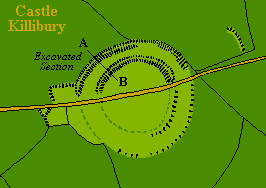 |
 |
|||
|
|
The concept of King Arthur's Capital is epitomised by the medieval Camelot, yet some of the earliest references to his court refer instead to the City of Celliwig, a name now associated with Killibury in Egloshayle, Cornwall. The Tradition: According to the Mabinogion tale of Culhwch & Olwen, King Arthur's Royal Palace was at Celliwig in Cornwall. From here, one of his Warband, Drem, could see a gnat as far away as Scotland; while another, Medyr, could shoot an arrow through the legs of a wren in Ireland! The Welsh Triads tell how "Medrod came to Arthur's Court at Celliwig in Cernyw; he left neither food nor drink in the court that he did not consume. And he dragged Gwenhwyfar from her Royal chair, and then he struck a blow upon her". They, furthermore, state that this place was one of the "Three Tribal Thrones of the Island of Britain": "Arthur as Chief
Prince in Mynyw (or Aberffraw), and Dewi as Chief Bishop, and Mælgwn
Gwynedd as Chief Elder; Modern Archaeology: Castle Killibury or Kelly Rounds is a small banked and ditched fort with a defended Eastern entrance. Lesser associated earthworks stand both to the North and the South. It may be either of Iron or Dark Age Construction. Small-scale excavations have uncovered several sherds of imported Mediterranean pottery from the latter period, indicating that the site was, at least, refortified during the 5th and 6th centuries. Possible Interpretations: The site of Celliwig has many Cornish claimants: Callington, Callywith, Gweek Wood, Barras Nose and Willapark. A place called Celliwig certainly once existed in Kernow (Cornwall - Cernyw in Welsh) as a Cornishman named Thomas de Kellewik is recorded in 1302. Opinion, however, varies as to whether this can be identified as the Caellwic which St. Dunstan records as having been given to the Diocese of Sherborne, by King Egbert, in 830. Killibury's parish, Egloshayle, is supposedly named after the Church-of-St.Hail, a son of King Brychan of Brycheiniog (though this is too disputed). It is less impressive than other supposed Royal Dark Age sites from Western Britain. However, pottery imports from the Middle East would still indicate an important chief lived there.
|
|||
| © Nash Ford Publishing 2001. All Rights Reserved. | ||||





 CASTLE KILLIBURY
CASTLE KILLIBURY